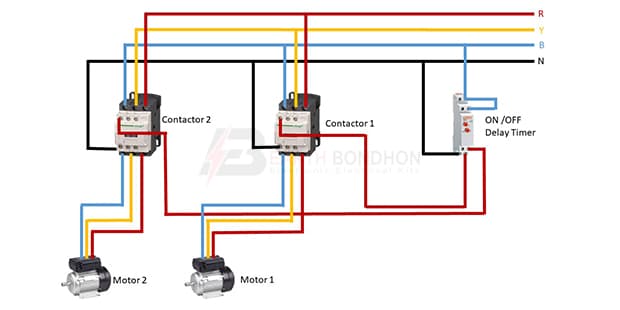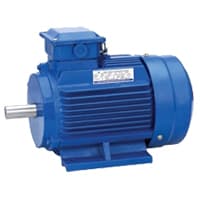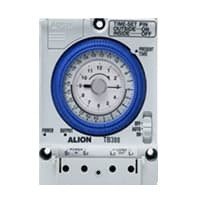On-Off Delay Timer Connection With Contactor:
This diagram shows how to make On-Off Delay Timer Connection With Contactor. In this circuit, we use an on/off delay timer, two magnetic contactors, and two 3-phase motors. First, we need to connect on delay timer and magnetic contactors with the power source. This circuit is very simple and easy to make. If you want to know more details about this circuit please check our youtube video below the post and stay with us for more updates.
Advertisements
Components needed For this Project:
You can get the components from any of the sites below:
- 3 Phase Motor (5 HP) [See Buy Click Amazon]
- Magnetic Contactor 40A [See Buy Click Amazon]
- 8 Pin Timer 220V AC [See Buy Click Amazon]
*Please note: These are affiliate links. I may make a commission if you buy the components through these links. I would appreciate your support in this way!
Advertisements
Components used to make the On-Off Delay Timer Connection With Contactor:
A 3-phase electric motor uses a 3-phase Power Supply to Convert Electric Energy into Mechanical Energy. It contains four Wires (Three hot Wires and one Neutral Wire) and Uses 3 Alternating Currents of the Same Frequency. Since it Generates a Rotating Magnetic Field, it does not need a Capacitor for the Startup. Some 3-phase Motors are Reversible, Which Means they can serve as Generators by Turning Mechanical Energy into Electrical Energy.
02. Magnetic Contactor:
A magnetic contactor is an electromagnetic switching device. It is generally used for controlling 3-phase Motors. The operation of a magnetic contactor is similar to that of a Relay. but a relay is used for low-power or low-voltage connections, and a magnetic contactor is used for high-power or high-voltage connections. As soon as the supply is applied to the magnetic contactor coil. its normally open contacts are closed and normally closed contacts are opened and the associated devices are also operated. This is how a magnetic contactor works.
A timer is a type of time-switching device that controls and controls Electrical circuits and electrical and electronic devices through time setting (on/off). The timer is basically 8-pin. Like other controlling devices the timer has a coil and when this coil is magnetized, the timer works on/off. The timer has 2 common ends and each common end has normally close and normally open options. When the timer is set by time, the timer trips at the end of that time and turns the common is normally closed (on) to open (off) and normally open (off) to close (on). This is how the timer works.
Thank You for visiting the website. Keep visiting for more Updates.
Frequently asked questions
OFF-delay timers are a type of time delay relay that opens and closes the circuit diagram as soon as power is removed. The contacts would not return to their normal position until the preset time delay has elapsed, at which point the load is de-energized. OFF-delay timers are often referred to as “delay on the break” timers.
An “ on-delay” timer starts the timing function immediately upon energization or then the contacts change state.” Off-delay” contacts change state immediately a stay changed until the power supply is removed and the timing function is complete. “Off-dela” is seldom used.
On-delay timer signals can be converted to off-delay signals with the use of an interposing normally open 3-way air-piloted valve. Air pressure is applied to the timer and to the operating device through the 3-way piloted valve.
Typically, a contractor will be used in situations where power supply loads need to be turned on and off frequently or rapidly. However, they can also be configured either to power supply on a circuit when activated (normally open, or NO contacts), or to shut down power to a circuit diagram when activated (normally closed, or NC contacts).
An on-delay timer will turn a device and system on after a set amount of time, while an off-delay timer will turn a device and system off after a set amount of time.
Read more Single Phase Wiring
What is a kilowatt-hour (kWh) | kwh formula | What does kwh mean
Introduction to Electrical Units and CircuitskW and kWh on your electricity bill As your home uses electricity during...
What is the Difference Between kVA | What does KVA mean | kVA formula
Difference Between KVA ExplainedWhat does KVA Mean? There are technical terms aplenty when it comes to generators, and...
Power Factor | Power Unit | Energy | Electricity Unit
Power factor definition | Calculating Power FactorPower Factor Values In a purely resistive circuit, the power factor...




0 Comments